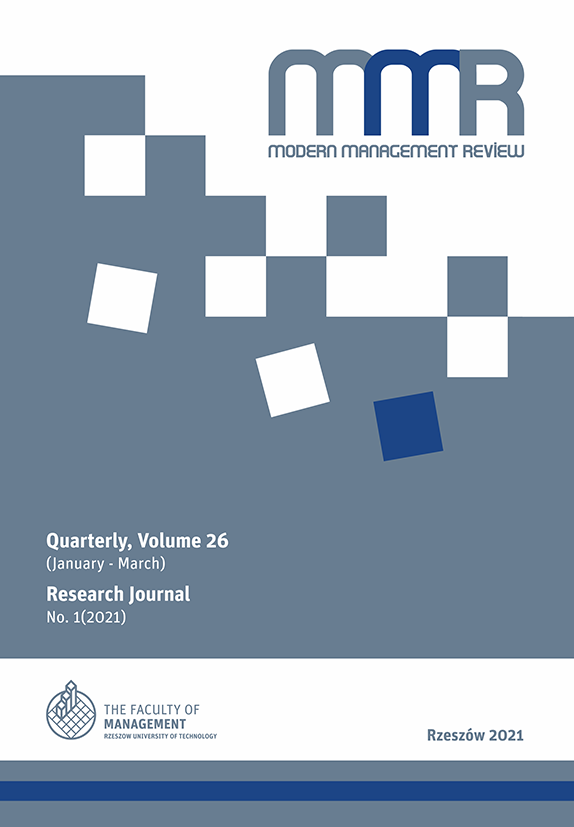Abstract
The aim of the article is to propose the combination of selected quality management instruments in a sequential and repetitive manner and to identify the incompatibilities and causes of its occurrence. This is a combination of techniques i.e.: brainstorming (BM), causes and effects diagram, multiply voting, and the 5Why method. The test of the proposed combination of the selected quality management instruments was made for the problem of the incompatibility of the product in an enterprise located in the Podkarpacie. This problem was the non-metallic inclusions on the bearing housing from CPW 407 steel. The proposed combination of the selected quality management instruments was integrated with the
non-destructive testing (NDT). The originality of the study is to propose the combination
of selected quality management instruments as a part of a single method, whose stages can occur in a sequential and repetitive manner.
References
Blocker, C., Flint, D., Myers, M., Slater, S. (2011). Proactive customer orientation and its role for creating customer value in global markets. “J. of the Acad. Mark. Sci.” 39. DOI: 10.1007/s11747-010-0202-9.
Cegliński, P. (2015). Najpopularniejsze instrumenty zarządzania. Przegląd badań empirycz-nych. „Acta Universitatis Nicolai Copernici” 1. DOI: 10.12775/AUNC_ZARZ.2015.002.
Cioccia, M. (2017). The Fishbone diagram to identify, systematize and analyze the sources of general purpose technologies. “Journal of Social and Administrative Sciences” 4(4).
Dziuba, S., Jarossova, M., Gołębiecka, N. (2014). Applying the 5 Why method to verification of non-compliance causes established after application of the Ishikawa diagram in the process of improving the production of drive half-shafts. “Production Engineering Archives” 2(1).
Ershadi, M., Kazemi, R. (2018). Root cause analysis in quality problem solving of research information systems: a case study. “Int. J. Productivity and Quality Management” 24(2).
Gołaś, H., Mazur, A., Mrugalska, B. (2016). Application of risk analysis and quality control methods for improvement of lead molding process. “Metalurgija” 55(4).
Hamrol, A. (2008). Zarządzanie jakością z przykładami. Warszawa: PWN.
Ilie, G., Ciocoiu, C. N. (2010). Application of fishbone diagram to determine the risk of an event with multiple causes. “Management Research and Practice” 2(1).
Ishii, K., Lee, B. (1996). Reverse Fishbone Diagram: A tool in aid of design for product retirement. “ASME DFM” 1–19.
Lawlor, K. B., Hornyak, M., J. (2012). Smart Goals: How The Application Of Smart Goals Can Contribute To Achievement Of Student Learning Outcomes. ”Developments in Business Simulation and Experiential Learning” 39.
Li, W., Pomegbe, W., Dogbe, C. (2018). Employees’ customer orientation and customer satisfaction in the public utility sector. The mediating role of service quality. “African Journal of Economic and Management Studies”. DOI: 10.1108/AJEMS-10-2018-0314.
Lis, T. (1995). Odsiarczanie stali wapniem i magnezem z udziałem tlenkowej fazy dyspersyjnej. „Hutnictwo. Zeszyty Naukowe Politechniki Śląskiej”, z. 49.
Luo, T., Wu, C., Duan, L. (2018). Fishbone diagram and risk matrix analysis method and its application in safety assessment of natural gas spherical tank. “Journal of Cleaner Production” 174. DOI: https://doi.org/10.1016/j.jclepro.2017.10.334.
Nilsson, L., Johnson, M., Gustafsson, A. (2001). The impact of quality practices on customer satisfaction and business results: product versus service organizations. “Journal of Quality Management” 6.
Pacana, A., Siwiec, D. Bednarova, L. (2019). Analysis of the incompatibility of the product with fluorescent method. “Matalurgija” 58(3–4).
Pacana, A., Siwiec, D., Bednárová, L. (2020). Method of Choice: A Fluorescent Penetrant Taking into Account Sustainability Criteria. “Sustainability”, 12. DOI: 10.3390/su12145854.
Pacana, A., Siwiec, D., Bednarova, L., Hajduova, Z. (2019). Wybrane metody zarządzania jakością stosowane do oceny druku etykiet. „Przemysł Chemiczny” 98(1). DOI: 10.15199/62.2019.1.17.
Putman, V., Paulus, P. (2008). Brainstorming, Brainstorming. Rules and Decision Making. “Journal of Creative Behavior”.
Rossiter, J., Lilien, G. (1994). New “Brainstorming” Principles. “Australian Journal of Management” 19(1).
Siwiec, D., Bednarova, L., Pacana, A. (2020). Metoda doboru penetrantów dla przemysłowych badań nieniszczących. „Przemysł Chemiczny” 99(5). DOI: 10.15199/62.2020.5.18.
Ulewicz, R. (2014). Practical application of quality tools in the cast iron foundry. “Manufacturing Technology” 14(1).
Wolniak, R. (2019). Downtime in the Automotive Industry Production Process – Cause Analysis. “Quality Innovation Prosperity” 23(2). DOI: 10.12776/QIP.V23I2.1259.
All texts published in the journal Modern Management Review are available in the full version on the website of MMR. Digital IDs have also been entered from number 19 (3/2012) (DOI: 10.7862/rz.2018.mmr.1)
Open Access – CC BY 4.0
This is an open access journal which means that all content is freely available without charge to the user or his/her institution. The articles are published under the terms of the Creative Commons licence (CC-BY 4.0), including the following fields of exploitation comprising:
1) the right to publish the Work in print in book and digital form and to distribute it in book and digital form, including by displaying, playing, broadcasting, making it publicly available by the Publisher and third parties,
2) the right to record and reproduce all or part of the Work on paper and in the form of a digital record and in any other possible way by the Publisher,
3) the right to enter the Work into computer memory and save the Work in the IT systems of the Publisher and other entities distributing digital content,
4) the right to archive the Work and make copies of the Work on electronic media by the Publisher, without quantitative restrictions,
5) the right to digitise the Work and to perform conversions/transformations of the Work in electronic form into other digital formats by the Publisher and third parties,
6) the right to distribute the Work, including via the Internet or other ICT networks by the Publisher and other third parties, in a way that allows viewing, reading, copying the content of the Work in electronic form, i.e. all elements belonging to it, whereby copying shall be understood as the saving of the Work made available to an interested person on a medium of their choice,
7) the right to store the Work in the database of the Publisher and other entities distributing the Work in any form, as well as its processing in the database of the Publisher and third parties,
8) right to translate and publish the Work in one of the modern languages in any form by the Publisher and third parties.


